Traditional Spanish Paella Recipe
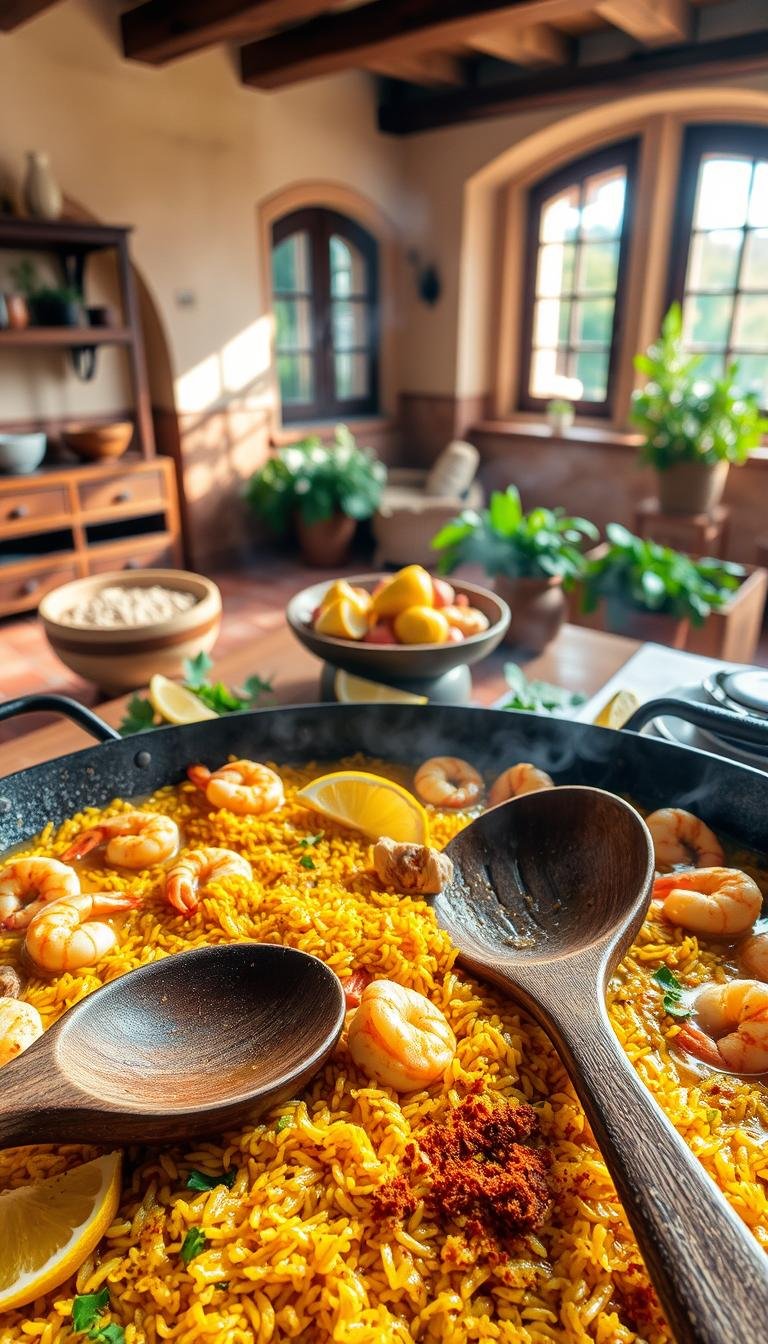
Have you ever tasted a dish that took you to another place? That happened to me with my first homemade Spanish paella. The blend of saffron, seafood, chicken, and colorful veggies created a masterpiece. It brought Spain’s flavors right into my kitchen!
Paella is more than a simple recipe. It’s a journey through Spain’s rich culinary world. Anyone can make it, whether you’re new to cooking or an expert. Imagine being at a Spanish party, with the lovely smell of saffron and garlic in the air.
Are you excited to try this amazing adventure? Let’s learn how to make this vibrant and tasty dish. It will surely be the highlight of your next party!
Key Takeaways
- Season chicken with salt and pepper before cooking to infuse flavor.
- Cook chicken in olive oil until browned on each side for about 6-8 minutes per side.
- Caramelize onions and cook peppers and garlic until tender for a rich, flavorful base.
- Add the harvested tomatoes, toast rice with saffron, and pour in stock while maintaining seasonings.
- Ensure to cook seafood and vegetables properly over low to medium heat.
- Allow the paella to rest for 15 minutes after cooking to soak in the flavors.
- Garnish with fresh parsley or cilantro before serving for a delightful finish.
Introduction to Paella: A Spanish Tradition
Paella isn’t just a meal; it’s a celebration! It comes from the Valencian Community in Spain. This area is near Valencia, by the Albufera lagoon. This famous Spanish rice dish has fans all over the world. It’s made in a big, shallow iron skillet. It has saffron rice, rabbit, chicken, and green beans. It’s a must-try, no matter if you’re new to Spanish recipes or already a great cook.
The name “paella” is from the word for frying pan in Valencian/Catalan. This dish is about more than just eating together. It’s about making memories. It’s usually cooked outside over a fire. They use branches from orange and pine trees. When the rice starts cooking, they don’t stir it. This lets the bottom layer get crispy and tasty. It’s known as “socarrat.”
There are many kinds of paella. You’ve got the traditional paella valenciana with short-grain rice. Examples include Bomba, Calasparra, or Senia rice. There’s seafood paella and mixed paella. There’s even black rice paella. This dish can change a lot! The taste comes from using good stuff like olive oil and saffron. There’s also smoked paprika and either meats or seafoods.
Making paella is an art. You start by sautéing the meat and veggies. Then, add the rice and broth. Finally, let it simmer just right. It’s served right from the pan. People eat from the edges moving in. This way, everyone gets some socarrat. So, for a family dinner or if you want to try something new, paella is a great choice. It brings people together beautifully.
Key Ingredients for Authentic Paella
Making a true Spanish paella starts with picking the right stuff. You need good rice, proteins, fresh veggies, and herbs. These bring out the real taste of *classic paella ingredients*.
Selecting the Right Rice
Good paella needs good rice. Use short-grain types like Bomba or Calasparra for *saffron-infused rice dishes*. They soak up lots of liquid but stay firm and tasty.
| Rice Type | Characteristics | Usage |
|---|---|---|
| Bomba | Short-grain, absorbs flavors | Preferred for authentic paella |
| Calasparra | Short-grain, non-sticky | Traditional choice for paella |
| Arborio | Short-grain, creamy texture | Used as an alternative |
Choosing Proteins: Meat and Seafood
The proteins make paella rich in taste. You can choose meat, seafood, or both from the *paella ingredients list*. Use chicken thighs, rabbit, prawns, mussels, and chorizo for their unique flavors.
| Protein | Characteristics | Usage |
|---|---|---|
| Chicken (thighs) | Moist and flavorful | Base protein for authentic paella |
| Rabbit | Gamey, tender meat | Together with chicken for traditional recipes |
| Prawns/Jumbo Shrimp | Sweet, firm texture | Enhances seafood paella |
| Mussels | Briny, chewy texture | Optional seafood addition |
| Chorizo sausage | Smoky, adds paprika flavor | Enhances meaty paella |
Fresh Vegetables and Herbs
Paella needs the fresh taste and look of veggies and herbs. Use bell peppers, peas, onions, garlic, and tomatoes. They make the dish taste and look great. Add herbs like parsley and saffron. They give a special taste and smell to your *saffron-infused rice dishes*.
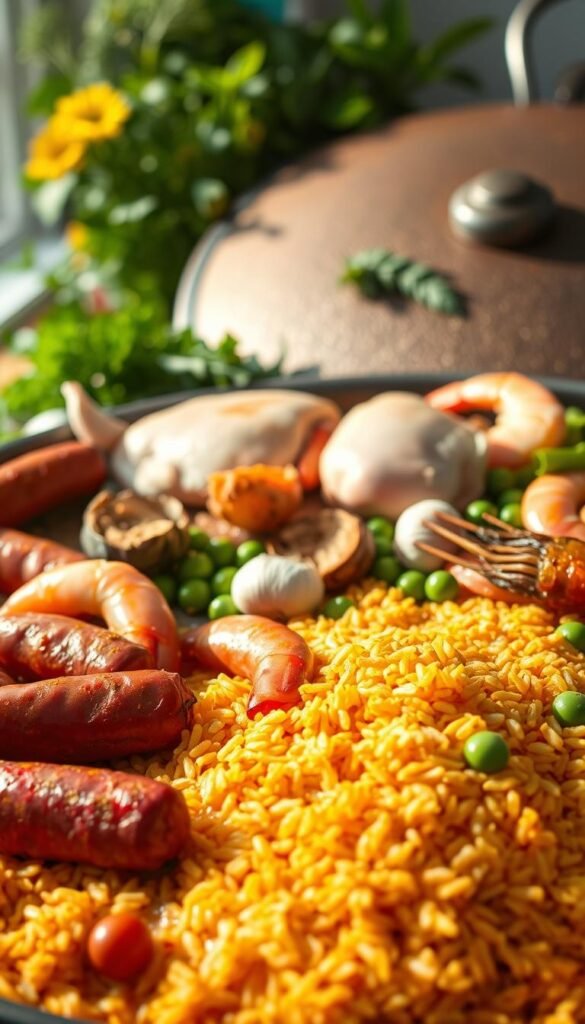
Adding these basic parts helps you make a real and tasty paella. This is the heart of Spanish cooking. Use fresh, quality items for the best paella!
Essential Equipment for Cooking Paella
Cooking a memorable Valencian paella needs the right tools. These tips will quickly make you a pro at Mediterranean rice. Let’s check out the must-haves.

Traditional Paella Pan
The *paellera* is key. This wide, shallow pan helps cook rice evenly. That’s how you get tasty socarrat. Choose carbon steel for quick heat changes and flavor. Enameled steel pans are easy to clean. They come in sizes from 20cm to 90cm.
Gas vs. Electric Cooking Options
Can’t decide between gas and electric? Gas burners, like Garcima’s, give consistent heat. They’re great outside. They fit different pan sizes well. Electric options are also good. They offer precise temperature control. Both types will help you cook rice perfectly.
Remember, tools like a long spoon and a pan scraper are important too. With these items, your Spanish rice will taste amazing. Shall we start cooking?
Step-by-Step Guide to Making Traditional Paella
Create mouthwatering paella with our step-by-step guide! Knowing the basics is crucial. Ready for a culinary journey? Let’s start!
Preparing the Base: Sofrito
For tasty paella, make a strong sofrito. First, heat 1/4 cup of extra virgin olive oil in a pan. Use medium heat. Add chopped onion and minced garlic. Cook them until they are soft.
Next, add diced tomatoes. Cook them for 30 to 45 minutes. You want them slightly caramelized. This base gives your paella its soul.
Adding Proteins and Vegetables
Now, add your proteins and veggies. For real Spanish flavor, use 4 boneless, skinless chicken thighs. And don’t forget seafood like jumbo shrimp, mussels, and calamari. Adding frozen peas gives color and texture. Make sure to lightly brown everything. This mix creates a tasty Spanish meal.

Mixing in the Rice
Cooking the rice right is essential for perfect paella. Use 2 cups of Spanish rice for the right texture. Mix the rice with the sofrito. Make sure all the rice is coated.
Then, add 5 cups of chicken broth. Also, add saffron for flavor. Don’t stir after adding the liquid. This gets you the crispy bottom known as socarrat. Cook on high for 5 minutes, then on medium for 10 minutes.
| Ingredients | Quantities |
|---|---|
| Spanish Rice (Bomba or Calaspara) | 2 cups |
| Extra Virgin Olive Oil | 1/4 cup |
| Chicken Thighs (boneless, skinless) | 4 |
| Assorted Seafood | Jumbo Shrimp, Mussels, Calamari |
| Frozen Peas | 1 cup |
| Saffron Threads | 1 pinch |
| Chicken Broth | 5 cups |
| Garlic | 1 clove |
| Onion | 1 medium |
| Ripe Tomatoes | 5 |
| Fresh Parsley and Lemon Slices (for garnish) | As needed |
Finish your paella by adding mussels, crabs, parsley, and lemon wedges. These touches make it look and taste great. Enjoy your Spanish masterpiece! Bon appétit!
Tips for Perfecting Your Paella
Making a perfect paella requires close attention and knowledge of Spanish cooking. Let’s look at important tips to make your paella amazing!
Cooking Techniques Explained
The secret to great paella is in handling heat and time well. First, choose top ingredients like saffron and extra virgin olive oil for the best taste and color.
Pick short or medium grain rice like Calasparra or Bomba for perfect flaky rice. Cook the rice for about 18 minutes, with high heat at first, then lower. Don’t stir the rice after adding liquid to keep it from getting sticky.

Use a carbon steel paella pan for even heat. Start with meats that walk, then those that fly, and end with sea creatures. This order matters for a tasty paella.
Importance of Resting the Paella
Resting the paella is often overlooked but very important. After it’s cooked, let it rest for 5 minutes. This step blends the flavors and settles the rice, enhancing every bite.
Variations of Traditional Paella
Paella can fit all kinds of tastes. Love the sea or like plants on your plate? There’s a paella for you. Let’s look at the most loved kinds.
Seafood Paella
On the coast, Paella Marinera is what people love. It has squid, prawns, mussels, and clams. The mix of seafood and spices smells amazing. It’s perfect if you love the sea’s flavors!

Valencian Paella
Traditional Valencian paella comes from Valencia. It’s made with rabbit, chicken, green beans, and maybe snails. The mix of tomato, pepper, onion, and garlic gives it the right taste. It shows off Spain’s cooking skills!
| Paella Type | Key Ingredients | Popularity |
|---|---|---|
| Seafood Paella | Squid, prawns, mussels, clams | High in coastal areas |
| Valencian Paella | Rabbit, chicken, green beans, snails | Authentic and traditional |
| Vegetarian Paella | Artichokes, asparagus, mushrooms | Popular for a plant-based diet |
Vegetarian Paella
For plant fans, vegetarian paella is great. It has artichokes, asparagus, and mushrooms. Even without meat, it’s full of flavor. It’s a tasty veggie choice!
Each paella type has its own special touch. You might like seafood, the original Valencian style, or veggie. There’s a flavor for everyone. So, get your paella pan ready and explore Spain’s favorite dish!
Common Mistakes to Avoid
Even skilled chefs can slip up when making Spanish rice in paella. We’ll look at these errors and how to dodge them in your cooking!
Overcooking the Rice
Overcooking the rice is a big mistake. For perfect paella, choosing the right rice like Bomba or Senia is vital. Cook it uncovered and stir only in the first 8 minutes.
Doing this keeps the rice from turning mushy. It helps keep the rice’s nice, firm feel that paella is known for.
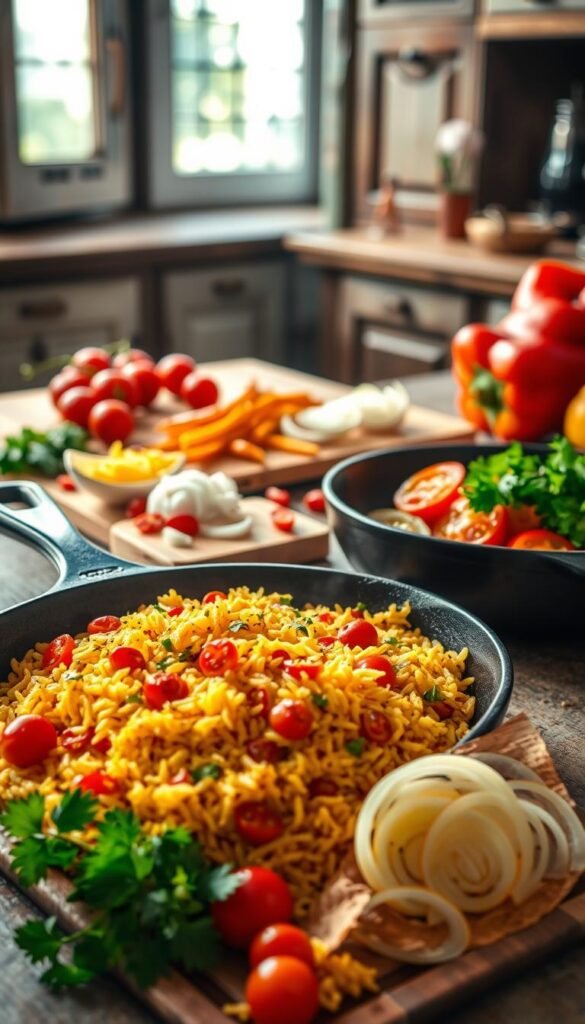
Skipping the Socarrat
Not making the socarrat is another mistake. This crispy rice layer comes from using the right paellera. A good pan makes sure the liquid evaporates right.
This layer makes the dish taste and feel awesome. Getting the socarrat right takes your paella from fine to amazing. Make sure to learn this!
Serving Suggestions for Paella
When serving paella, aim to make the experience unforgettable. Focus on the presentation for traditional paella. Also, choose the best sides to match. Let’s look at what makes paella dishes stand out!
Ideal Accompaniments
Choose side dishes that boost your paella’s taste. They should not overwhelm the main flavors. Seafood paellas go well with light sides. Here are my top picks:
| Side Dish | Description |
|---|---|
| Pa Amb Tomàquet | Spanish bruschetta with fresh tomatoes and olive oil. |
| Patatas Bravas | Spicy fried potatoes with a creamy aioli. |
| Blistered Shishito Peppers | Smoky and slightly charred, these peppers are a fantastic match. |
| Grilled Shrimp Skewers | Topped with green tahini sauce, bringing an extra burst of flavor. |
| Octopus Ceviche | Tangy and refreshing, perfect for seafood lovers. |
| Prosciutto Wrapped Avocado Bites | A delightful mixture of creamy avocado and salty prosciutto. |
| Simple Arugula Salad | Served with a red wine vinaigrette, a fresh side to cleanse the palate. |
| Sous Vide Asparagus | Infused with garlic or lemon, this brings a crisp freshness. |
| Spanish Ham Croquettes | Croquetas de jamón are a creamy, savory addition. |
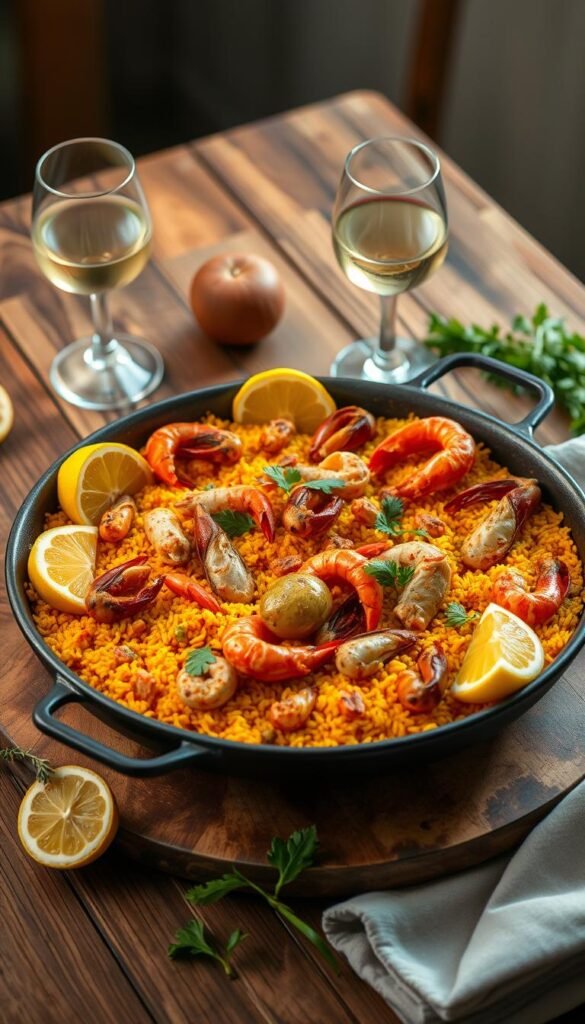
Pairing with Wine
Picking the right wine can make your paella even better. Here are some great choices:
| Wine | Description |
|---|---|
| Spanish Rioja | A bold red that pairs perfectly with the rich flavors of paella. |
| Cava | These bubbles complement the dish’s richness delightfully. |
| White Rioja | Light-bodied and refreshing, ideal for seafood paella. |
| Garnacha (Grenache) | For red wine lovers, Garnacha offers a wonderful pairing. |
| Verdejo | A crisp white that enhances the Spanish meals with seafood flavors. |
Add lemon wedges and quick aioli to your paella for extra flavor. Don’t forget a glass of refreshing sangria. Your guests will love the effort you’ve made!
Frequently Asked Questions about Paella
When you’re exploring the best paella recipe, you might have some questions. We’ll cover the most common ones. This will make cooking traditional Spanish Paella Recipe easier!
What is the Best Rice for Paella?
Choosing the right rice is key for a good paella. Bomba, Arborio, or Calasparra rice are top choices. They soak up the flavors well and keep their shape.
Did you know the name “paella” comes from the pan it’s cooked in? It comes from “patella”, a Latin word. That’s pretty cool!
Can I Make Paella Ahead of Time?
Best enjoyed fresh, paella can still be prepped early. You can cut the vegetables and prep the seafood in advance. Yet, it’s best to cook and serve it right away for the best taste and texture.
Here’s a key seafood paella tip: Don’t stir after adding the broth. This helps form a tasty crispy socarrat at the bottom. It’s a special part of the dish.

Perfect paella is in the details. Use saffron for true flavor, and follow these seafood paella tips. You’re ready to conquer the best paella recipe. Happy cooking!
Conclusion: Enjoying Your Homemade Paella
Cooking is more than just following a recipe. It’s about enjoying making the food and eating it! Each spoonful of your homemade paella is full of Spanish culture and taste. With every bite, enjoy the mix of flavors and sharing a beautiful meal with your family and friends.
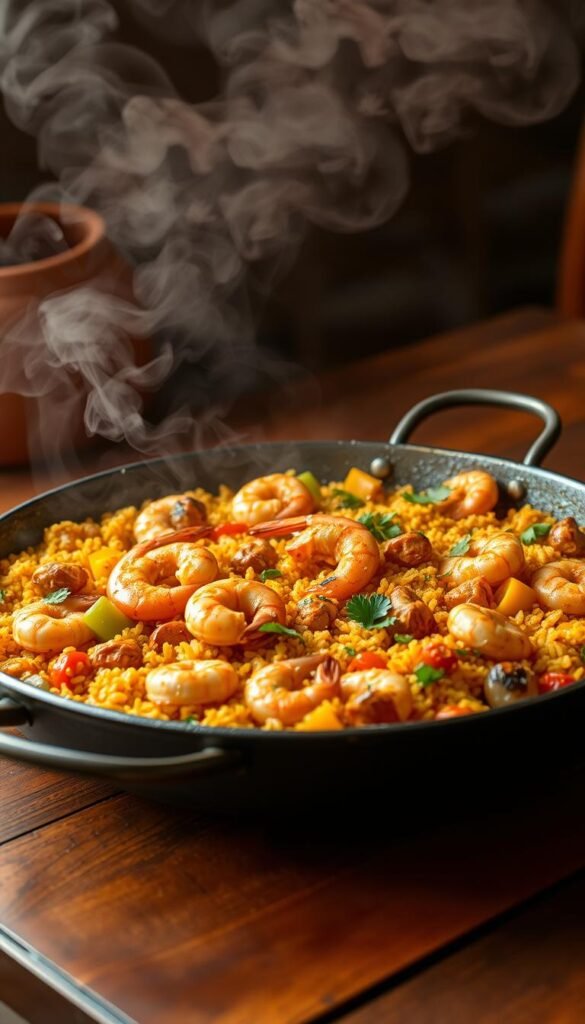
Making your own paella is special because you learn about Spanish traditions. Like the part where you slightly burn the bottom of the pan on purpose. This adds a yummy crunch that many love.
With easy Spanish recipes, you can bring Spain to your table. You can make paella with seafood, or with lots of vegetables. This dish can be made in many ways.
Paella is great for bringing people together. Imagine sitting down with your loved ones. Everyone is excited to eat rice colored with saffron, which is very expensive. This sharing is what makes cooking tips from Spain so loved.
So, call everyone to the table, serve your paella, and dive into the Spanish way of cooking at home. Your paella is not just food—it’s a party of tradition, taste, and being together. Enjoy your meal!
Resources for Further Reading on Paella
Want to learn more about paella making? There’s so much to discover! I’ll share great resources to help you grow your cooking skills. You can try different recipes and learn new things. Explore cookbooks and online classes filled with paella secrets for every chef.
Recommended Cookbooks
A good cookbook is like a trusted friend in your kitchen. If you want to get better at making paella, check out “Paella!” by Penelope Casas and “The New Spanish Table” by Anya von Bremzen. These books teach you classic and new paella styles. You’ll learn about the perfect socarrat, where to find the best ingredients, and much more.
Online Cooking Classes
Prefer learning by doing? Enroll in an online cooking course. MasterClass and Spain on a Fork have special courses on Spanish food. Learn the secrets of great rice dishes from expert chefs. These classes are great for perfecting seafood and mixed paella techniques.
Ready to start your paella cooking adventure? Explore, learn, and enjoy making delicious paella!